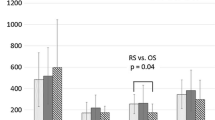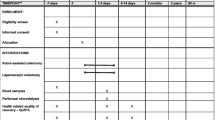Abstract
Background
Surgical interventions activate a cascade of reactions that result in an aseptic inflammatory reaction. This inflammatory response initiates the organism’s innate immunity. Laparoscopic surgery reduces the trauma, and patients benefit from diminished surgical trauma and maintained immune function. Cytokine levels and C-reactive protein (CRP) are related to the magnitude of surgical trauma and surgical stress. Toll-like receptors (TLRs) 2 and 4 are the first sensor-recognition receptors of the invading pathogens for the innate immune response. This study aimed to compare the inflammatory response and then the stress response during laparoscopic and open colectomy for cancer by calculating TLR-2 and TLR-4 as the first sensor-recognition receptors together with interleukin-6 (IL-6), tumor necrosis factor-α (TNF-α), and high-sensitivity CRP (hsCRP).
Methods
A total 40 patients with colorectal cancer were randomized in two groups: group A (open colectomy, n = 20) and group B (laparoscopic colectomy, n = 20). An epidural catheter was placed in all patients 1 h preoperatively. Rupivocaine was administered perioperatively and 48 h postoperatively. Blood samples were taken for calculation of IL-6, TNF-α, hsCRP, TLR-2, and TLR-4 preoperatively and 5 min after deflation of pneumoperitoneum (group B) or 5 min after division of the colon (group A), then 6 and 24 h postoperatively.
Results
The mean operative time was 115 for group A and 142 min for group B. The mean blood loss was respectively 240 and 105 ml (P < 0.001), and the mean hospital stay was respectively 8 and 5 days (P < 0.05). The IL-6 level was significant higher in group A than in group B at 6 and 24 h postoperatively (P < 0.0001), and the hsCRP level was significant higher in group A than in group B at 24 h postoperatively (P < 0.001). The TNF-α values did not differ between the two groups. The TLR-2 level was significantly higher in group A than in group B at 5 min (P = 0.013) and 24 h (P = 0.007) postoperatively. The TLR-4 level was significant higher in group A than in group B at 5 min postoperatively (P = 0.03).
Conclusion
The inflammatory response and the resultant stress response are significantly less during laparoscopic colectomy than during open colectomy for colorectal cancer. This is an obvious short-term clinical benefit for the patient, providing tinder for further study to investigate the long-term results of laparoscopic colectomy versus open colectomy for colorectal cancer (Registered clinical trial no. NCT00942461; www.clinicaltrials.gov).


Similar content being viewed by others
References
Gunliffe RN (2003) Alpha-defensins in the gastrointestinal tract. Mol Immunol 40:463–467
Gunliffe RN, Kamal M, Rose FRA, James PD, Mahida YR (2002) Expression of antimicrobial neutrophil defensins in epithelial cells of active inflammatory bowel disease mucosa. J Clin Pathol 55:298–304
Kwok SPY, Lau WY, Carey PD, Kelly SB, Leung KL, Li AKC (1996) Prospective evaluation of laparoscopic-assisted large bowel excision for cancer. Ann Surg 223:170–176
Schwenk W, Jacobi C, Mansman U, Böhus B, Müller JM (2000) Inflammatory response after laparoscopic and conventional colorectal resections: results of a prospective randomized trial. Langenbecks Arch Surg 385:2–9
Allendorf JDF, Bessler M, Kayton ML, Oesterling SD, Tret MR, Nowygrod R, Whelan RL (1995) Increased tumor establishment and growth after laparotomy vs laparoscopy in a murine model. Arch Surg 130:649–653
Hildebrandt U, Kessler K, Plusczyl T, Pistorius G, Vollmar B, Menger MD (2003) Comparison of surgical stress between laparoscopic and open colonic resections. Surg Endosc 17:242–246
Baigrie RJ, Lamont PM, Kwiatkowski D, Dallman MJ, Morris PJ (1992) Systemic cytokine response after major surgery. Br J Surg 79:757–760
Yuan Q, Walker WA (2004) Innate immunity of the gut: mucosal defense in health and disease. J Pediatr Gastroenterol Nutr 38:463–473
Ikushima H, Nishida T, Takeda K, Ito T, Yasuda T, Yano M, Akira S, Matsuda H (2004) Expression of toll-like receptors 2 and 4 is downregulated after operation. Surgery 135:376–385
Beutler B (2002) Toll-like receptors: how they work and what they do. Curr Opin Hematol 9:2–10
Lacy AM, Garcia-Valdecasas JC, Delgado S, Castells A, Taurá P, Piqué JM, Visa J (2002) Laparoscopy-assisted colectomy versus open colectomy for treatment of non-metastatic colon cancer: a randomized trial. Lancet 359:2224–2229
Turunen P, Carpelan-Holmström M, Kairaluoma P, Wikström H, Kruuna O, Pere P, Bachmann M, Sarna S, Scheinin T (2009) Epidural analgesia diminished pain but did not otherwise improve enhanced recovery after laparoscopic sigmoidectomy: a prospective randomized study. Surg Endosc 23:31–37
Tsujimoto H, Ono S, Majima T, Efron PA, Kinoshita M, Hiraide H, Moldawer LL, Mochizuki H (2006) Differential toll-like receptor expression after ex vivo lipopolysaccharide exposure in patients with sepsis and following surgical stress. Clin Immunol 119:180–187
Gupta A, Watson DI (2001) Effect of laparoscopy on immune function. Br J Surg 88:1296–1306
Buunen M, Gholghesaei M, Veldkamp R, Meijer DW, Bonjer HJ, Bouvy ND (2004) Stress response to laparoscopic surgery. Surg Endosc 18:1022–1028
Gabay C, Kushner I (1999) Acute-phase proteins and other systemic responses to inflammation. N Engl J Med 340:448–454
Cruickshank AM, Fraser WD, Burns HJ, Van Damme J, Shenkin A (1990) Response of serum interleukin-6 in patients undergoing elective surgery varying severity. Clin Sci London 79:161–165
Grande M, Tucci GF, Adorisio O, Barini A, Rulli F, Neri A, Franchi F, Farinon AM (2002) Systemic acute-phase response after laparoscopic and open cholecystectomy. Surg Endosc 16:313–316
Liang JT, Shieh MJ, Chen CN, Cheng YM, Chang KJ, Wang SM (2002) Prospective evaluation of laparoscopy-assisted colectomy versus laparotomy with resection for management of complex polyps of the sigmoid colon. World J Surg 26:377–383
Uzunkoy A, Coskun A, Akinci OF, Kocyigit A (2000) Systemic stress responses after laparoscopic and open hernia repair. Eur J Surg 166:467–471
Trinchieri G, Sher A (2007) Cooperation of toll-like receptor signals in innate immune defence. Nature Rev Immunol 7:179–190
Lemaitre B (2004) The road to toll. Nature Rev Immunol 4:521–527
Akira S, Uematsu S, Takeuchi O (2006) Pathogen recognition and innate immunity. Cell 124:783–801
Medzhitov R, Janeway CA Jr (1997) Innate immunity: the virtues of a nonclonal system of recognition. Cell 91:295–298
Beutler A, Poltorak A (2001) Toll we meet again. Immunology 2:9–10
Schwandner R, Dziarski R, Wesche H, Rothe M, Kirschning CJ (1999) Peptidoglycan- and lipoteichoic acid-induced cell activation is mediated by toll-like receptor 2. J Biol Chem 274:17406–17409
Yang H, Young DW, Gusovsky F, Chow JC (2000) Cellular events mediated by lipopolysaccharide-stimulated toll-like receptor 4: MD-2 is required for activation of mitogen-activated protein kinases and Elk-1. J Biol Chem 275:20861–20866
Kimura F, Shimizu H, Yoshidome H, Ohtsuka M, Miyazaki M (2010) Immunosuppression following surgical and traumatic injury. Surg Today 40:793–808
Riedemann NC, Guo RF, Ward PA (2003) Novel strategies for the treatment of sepsis. Nat Med 9:517–524
Offner PJ, Moore EE, Ciesla D (2002) The adrenal response after severe trauma. Am J Surg 184:649–653
Keh D, Boehnke T, Weber-Cartens S, Schulz C, Ahlers O, Bercker S (2003) Immunologic and hemodynamic effects of “low-dose” hydrocortisone in septic shock: a double-blind, randomized, placebo-controlled, crossover study. Am J Respir Crit Care Med 167:512–520
Lacy AM, Delgado S, Castells A, Prins HA, Arroyo V, Ibarzabal A, Pique JM (2008) The long-term results of a randomized clinical trial of laparoscopy-assisted versus open surgery for colon cancer. Ann Surg 248:1–7
Mc Carter MD, Mack VE, Daly JM, Naama HA, Calvano SE (1998) Trauma-induced alterations in macrophage function. Surgery 123:96–101
Kawasaki T, Ogata M, Kawasaki C, Tomihisa T, Okamoto K, Shigematsu A (2001) Surgical stress induces endotoxin hyporesponsiveness and an early decrease of monocyte mCD14 and HLA-DR expression during surgery. Anesth Analg 92:1322–1326
Wolska A, Lech-Maranda E, Robak T (2009) Toll-like receptors and their role in carcinogenesis and anti-tumor treatment. Cell Molec Biol Lett 14:248–272
Wang HY, Wang R-F (2007) Regulatory T cells and cancer. Curr Opin Immunol 19:217–223
Acknowledgments
The authors thank Professor Charalampos Moutsopoulos, MD, PhD, Chairman of Pathologic Physiology at Athens University, School of Medicine, for the help with knowledge concerning TLRs.
Disclosures
Konstantinos E. Tsimogiannis, Constantinos C. Tellis, Alexandros D. Tselepis, George K. Pappas-Gogos, Evangelos C. Tsimoyiannis, and George Basdanis have no conflicts of interest or financial ties to disclose.
Author information
Authors and Affiliations
Corresponding author
Rights and permissions
About this article
Cite this article
Tsimogiannis, K.E., Tellis, C.C., Tselepis, A.D. et al. Toll-like receptors in the inflammatory response during open and laparoscopic colectomy for colorectal cancer. Surg Endosc 26, 330–336 (2012). https://doi.org/10.1007/s00464-011-1871-2
Received:
Accepted:
Published:
Issue Date:
DOI: https://doi.org/10.1007/s00464-011-1871-2




